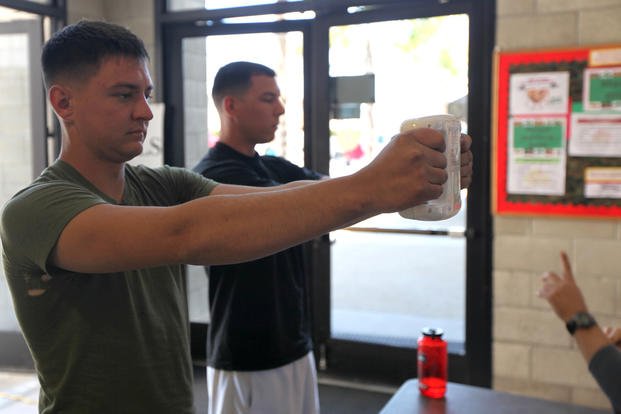The Marine Corps Physical Conditioning Program has two main components: the physical fitness test (PFT) and the Body Composition Program.
The Marine Corps' weight and body fat standards are health and performance based, and not based on appearance. Marines are considered not within these standards when their body weight and body fat exceed the maximum limits.
Like the Marine Corps PFT, the weigh-in is conducted on a semiannual basis (annually for Reserves). And like the PFT, it is conducted in green-on-green T-shirt and shorts, and socks.
Body Composition Program in the Marine Corps
If a Marine's weight exceeds the regulation limits, they will be measured for body fat. Marines who exceed the body-fat allowance are enrolled in the Body Composition Program.
If the Marine fails to lose the required weight and body fat required to meet standards while enrolled in the Body Composition Program, this may result in an involuntary discharge.
Marines who are over the weight on the chart but meet the body-fat standards are considered to be within the required standards, and no further action is taken.
The height/weight standards charts
Male and female Marine Corps height/weight standards charts (inches/pounds)
| MALE | FEMALE | |||
| Height | Max Weight | Min
Weight |
Max Weight | Min
Weight |
| 56 | 122 | 85 | 115 | 85 |
| 57 | 127 | 88 | 120 | 88 |
| 58 | 131 | 91 | 124 | 91 |
| 59 | 136 | 94 | 129 | 94 |
| 60 | 141 | 97 | 133 | 97 |
| 61 | 145 | 100 | 137 | 100 |
| 62 | 150 | 104 | 142 | 104 |
| 63 | 155 | 107 | 146 | 107 |
| 64 | 160 | 110 | 151 | 110 |
| 65 | 165 | 114 | 156 | 114 |
| 66 | 170 | 117 | 155 | 117 |
| 67 | 175 | 121 | 161 | 121 |
| 68 | 180 | 125 | 171 | 125 |
| 69 | 186 | 128 | 176 | 128 |
| 70 | 191 | 132 | 181 | 132 |
| 71 | 197 | 136 | 186 | 136 |
| 72 | 202 | 140 | 191 | 140 |
| 73 | 208 | 144 | 197 | 144 |
| 74 | 214 | 148 | 202 | 148 |
| 75 | 220 | 152 | 208 | 152 |
| 76 | 225 | 156 | 213 | 156 |
| 77 | 231 | 160 | 219 | 160 |
| 78 | 237 | 164 | 225 | 164 |
| 79 | 244 | 168 | 230 | 168 |
| 80 | 250 | 173 | 236 | 173 |
| 81 | 256 | 177 | 242 | 177 |
| 82 | 263 | 182 | 248 | 182 |
If a Marine is below the minimum standards for weight, there is no action taken. However, the command may refer the Marine to human performance specialists or a nutritionist to make sure they are consuming a healthy diet and eating enough.
Marine body-fat standards
The Marine Corps changed its body-fat standards and age groups for the PFT, combat fitness test (CFT) and Body Composition Program, effective in 2017. These new standards are as follows:
As of 2017, Marines may have their body-fat composition disregarded if they master the PFT and CFT. The requirements are extremely challenging, however: A score of 285 or higher is required on both tests to be completely exempt from body-fat limits.
A score of 250 or above allows an additional 1% of body fat per the guidelines. The maximum body-fat percentages Marines at each age group can have are listed below:
Male Marines
- Ages 17-20: 18%
- Ages 21-25: 18%
- Ages 26-30: 19%
- Ages 31-35: 19%
- Ages 36-40: 20%
- Ages 41-45: 20%
- Ages 46-50: 21%
- Ages 51+: 21%
Female Marines
- Ages 17-20: 26%
- Ages 21-25: 26%
- Ages 26-30: 27%
- Ages 31-35: 27%
- Ages 36-40: 28%
- Ages 41-45: 28%
- Ages 46-50: 29%
- Ages 51+: 29%
While on the Body Composition Program, if a Marine fails to lose the required weight/body fat to get within standards, they ultimately can be discharged from the Marine Corps. If the Marine meet the new standards, they will be removed from the BCP and allowed to stay in the service.
Stew Smith is a former Navy SEAL and fitness author certified as a Strength and Conditioning Specialist (CSCS) with the National Strength and Conditioning Association. Visit his Fitness eBook store if you’re looking to start a workout program to create a healthy lifestyle. Send your fitness questions to stew@stewsmith.com.
Want to Learn More About Military Life?
Whether you're thinking of joining the military, looking for fitness and basic training tips, or keeping up with military life and benefits, Military.com has you covered. Subscribe to Military.com to have military news, updates and resources delivered directly to your inbox.


















